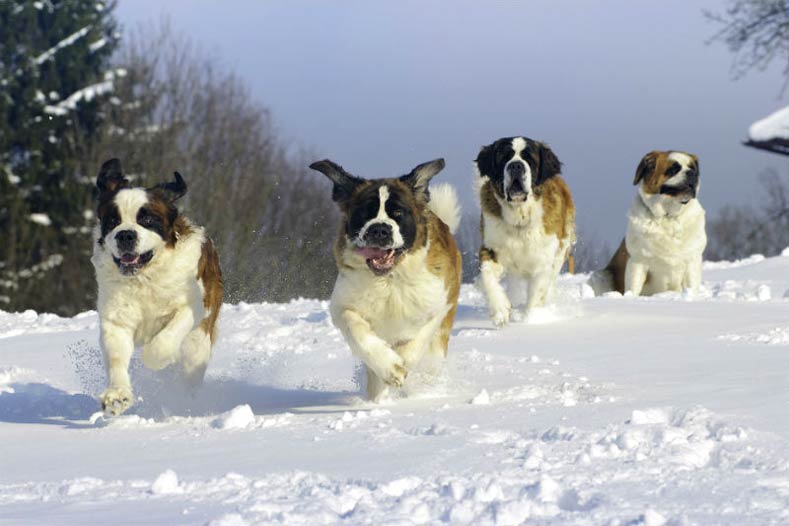
Movement involves every part of a dog’s construction, and because no two breeds move exactly alike, the study of movement can be a life’s work.
Expert breeders and anatomists have written shelves full of books on the subject, and gifted photographers and filmmakers have documented canine locomotion in minute detail.
Here, then, are just a few basics to consider when watching your canine athlete on the move.
Fore and Aft
The engine that drives the canine machine is the hindquarters, “especially the combination of the pelvic and upper thigh muscles, assisted by the lower thigh-muscle groups,” wrote canine anatomy expert Howard Spira. In the written AKC standards of breeds built to work long and hard, descriptions of hindquarters abound with words like “muscular,” “well-muscled,” and “powerful.” Police-dog handlers tell us that when an aging K-9’s back end begins to erode—when the dog loses the explosive first step that enables him to spring into action—it’s time for their partner to retire.
The forequarters play a relatively small part in actual propulsion, but their importance should not be understated. The front paw carries at least 60 percent of the dog’s weight, and “modern studies indicate that the percentage of weight borne on the front feet may be closer to 75 percent in some breeds,” Curtis Brown wrote in his “Dog Locomotion and Gait Analysis.” The front end is also the steering mechanism and the brakes, and it takes the impact of landing when the dog is jumping or running.
Also vital to canine locomotion are the paw pads. “If the heel pad is thick and well built-up it will not only stand more shock and rough use over ground,” McDowell Lyon explains in the book “The Dog in Action,” “it will increase endurance by shortening the leverage action.” Thick pads absorb more shock and increase endurance. Rough pads allow for better traction and quick turns. Paws and pasterns (the canine version of wrists) work together to absorb the shock of jumping and running, while ensuring flexible movement.
The Same But Different
A well-bred dog will move soundly, but correct movement differs from breed to breed. The galumphing Newfoundland is not a nimble-footed Border Collie. A Norfolk Terrier doesn’t stride like a Vizsla.
To picture your dog’s correct movement, consider its background and job description. History reveals the original function, and the standard describes movement necessary to perform that function in the breed’s ancestral homeland.
Even among dogs bred for the same purpose, gait can differ. “The gait of the Golden Retriever differs substantially from that of his cousin, the Labrador,” said Rick Beauchamp, the late AKC judge of sporting dogs. “And though seldom considered, there is a visible difference in how the well-made Irish and Gordon setters move.”
Ireland is known for its wide, flat meadows, so Irish huntsmen wanted their sleek, rangy setters to move freely and swiftly.
But the Scots needed a setter who could flush and retrieve on rocky, punishing terrain. Thus we have the Gordon Setter: a shorter-coupled, heavier-bodied dog with a more deliberate but steady pace.
“This is not to say that the Gordon is a plodder—but one shouldn’t expect the lightness typical of his Irish cousin,” Beauchamp said. “There is a difference in the way the two breeds are made, and a characteristic difference in the way they perform.”
Gaiting to a Different Drummer
Here are five dogs whose unique movement sets them apart, with quotes from their breed standards:
Bulldog “The style and carriage are peculiar, his gait being a loose-jointed, shuffling, sideways motion, giving the characteristic roll.”
Miniature Pinscher “The hackney-like action is a high-stepping, reaching, free and easy gait in which the front leg moves straight forward and in front of the body and the foot bends at the wrist.”
Neapolitan Mastiff “The Neapolitan Mastiff’s movement is not flashy, but rather slow and lumbering. … Rolling motion and swaying of the body at all gaits is characteristic.”
Norwegian Lundehund “As the Lundehund is designed to climb steep cliffs and work into narrow crevices, the front assembly must be flexible and wide. This produces an elastic gait with a unique rotary front movement.”
Pekingese “It is unhurried, dignified, free and strong, with a slight roll over the shoulders. This motion is smooth and effortless and is as free as possible from bouncing, prancing or jarring.”

